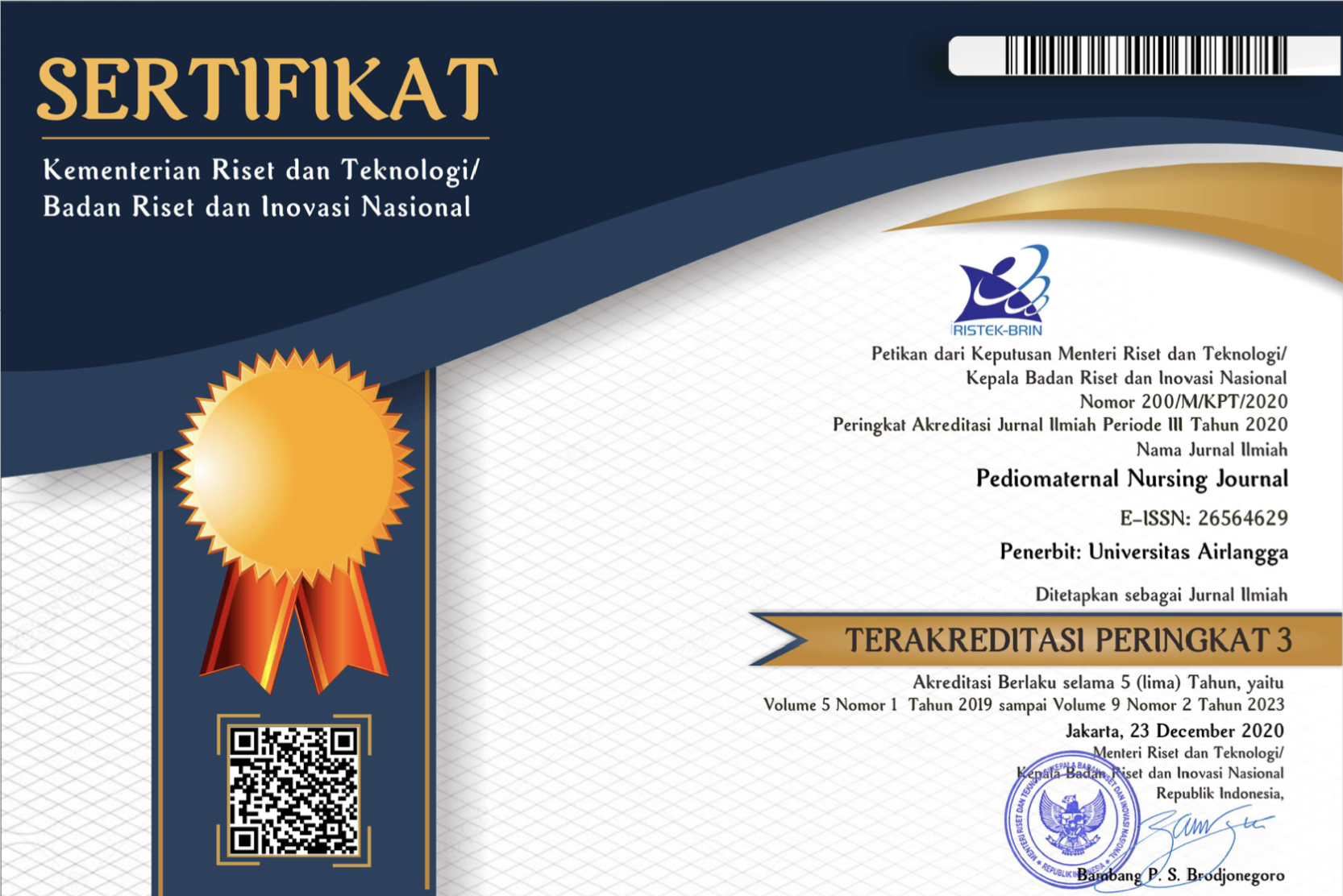FAKTOR PELAKSANAAN KANGAROO MOTHER CARE PADA BAYI BBLR
Downloads
Introduction: Until recently, Low Birth Weight Babies (LBWB) has become an issue in Indonesia which causes morbidity and mortality during neo-natal period. A common problem found on LBWB is instable body temperature. An effort to solve this problem is done by treating LBWB in incubators. However, the limited incubator facility increases hypothermia on LBWB. Kangaroo Mother Care (KMC) treatment is very effective to solve this problem. This research aims to understand the factors related to Kangaroo Mother Care (KMC) implementation on LBWB at Dr. Soetomo General Hospital nursery room.
Method: This is a descriptive analytical research using cross-sectional approach. The sample of this research was the mothers of low birth weight babies being treated at nursery room of Dr. Soetomo General Hospital, Surabaya which consists of 15 respondents determined by inclusion criteria. The data were collected using questionnaire and observations on the respondents. Statistical test used in this research was spearman rho correlation test with p≤ 0.05 as the significance level.
Result: The findings of this research indicated that KMC was well implemented at the nursery room of Dr. Soetomo General Hospital, Surabaya. There was a significant relationship between mothers' knowledge and the implementation of KMC (p=0.027; r=0.567), and a significant relationship between mothers' attitude and the implementation of KMC (p=0.027; r=0.643). There was also a significant relationship between family support and the implication of KMC (p=0.032; r=0.554).
Discussion: It can be concluded that better knowledge, attitudes, and support on kangaroo mother care can improve the implementation of KMC on mothers with low birth weight babies. Mothers' attitude is the dominant factor on Kangaroo Mother Care (KMC) implementation. As the suggestion, further researches should involve more respondents in order to obtain more accurate result.
Arikunto, S. (2006). Prosedur Penelitian Suatu Penedekatan Praktik. Jakarta: Rineka Cipta, hal. 246.
Azwar, S. (2011). Sikap Manusia Teori dan Pengukurannya. Edisi ke-2. Yogyakarta: Pustaka Pelajar, hal. 66.
Bobak, Lowdermilk & Jensen. (2005). Buku Ajar Keperawatan Maternitas, edisi 4, Jakarta : EGC, hal. 888-890.
Badan Penelitian dan Pengembangan Kesehatan. Laporan Hasil
Riset Kesehatan Dasar 2010. Jakarta; Kementrian Kesehatan, RI
Badan Pusat Statistik (BPS).Badan Kependudukan dan Keluarga Berencana Nasional. Survei Demografi dan Kesehatan Indonesia 2012. Measure DHS ICF International. Calverton, Maryland, USA: BPS dan Measure DHS ICF International. (2012). Diakses 2 oktober 2013, < http://www.bkkbn.go.id >
Departemen Kesehatan Republik Indonesia. (2008). Paket Pelatihan Pelayanan Obstetri Dan Neonatal Emergensi Komprehensif (PONEK) Asuhan Neonatal Esensial.
Divisi Neonatologi Ilmu Kesehatan Anak Rumah Sakit Dr Soetomo Surabaya. (2008). Manajemen Bayi Baru Lahir, tulisan dipresentasikan pada Tatalaksana Masalah Kesehatan Ibu dan Bayi Bagi Perawat dan Bidan, Surabaya, 16-18 Mei
Dharma, K. (2011), Metode Penelitian Keperawatan. Jakarta: Trans Info Media
Effendi & Makhfudli. (2009). Keperawatan Kesehatan Komunitas Teori dan Praktik Dalam Keperawatan. Jakarta: Salemba Medika.
Effendy, N. (1998). Dasar-Dasar Keperawatan Kesehatan Masyarakat. Jakarta: EGC, hal. 232-235
Friedman & Marilyn. (1998). Buku Ajar Keperawatan Riset, Teori & Praktik. Jakarta: EGC, hal. 31.
Hidayat, A. (2011). Metode Penelitian Keperawatan Dan Teknik Analisis Data. Jakarta: Salemba Medika
Ikatan Dokter Anak Indonesia. (2010). Buku Ajar Neonatologi. Jakarta : Badan Penerbit IDAI.
Lawn, J.E. (2010). ‘Kangaroo Mother Care' to prevent neonatal deaths due to preterm birth complications. International Journal of Epidemiology 2010;i144-i154 doi:10.1093/ije/dyq031_, diakses 24 September 2013, < http://ncbi.nlm.gov/pubmed/21412879 >.
Mardapi, D. (2007). Teknik Penyusunan Instrumen Tes Dan Non Tes. Yokyakarta: Mitra Cendekia.
Notoatmodjo, S. (2012). Promosi Kesehatan Dan Perilaku Kesehatan. Jakarta : Rineka Cipta.
, (2003). Pendidikan dan Perilaku Kesehatan, Jakarta: Rieka Cipta
Nursalam. (2013). Metodologi Penelitian Ilmu Keperawatan. Jakarta: Salemba Medika
Nursalam & Siti, P, (2001). Konsep dan Penerapan Metodologi Keperawatan. Jakarta: Salemba Medika.
PERINASIA. (2008). Perawatan Bayi Berat Lahir Rendah (BBLR) dengan Metode Kanguru. Jakarta
PERINASIA. (2010). Konsep Dasar Perawatan Metode Kanguru, tulian dipresentasikan pada Pelatihan Perawatan Metode Kanguru. Surabaya, 15-19 Pebruari
Putra, S. ( 2010). Filsafat Ilmu Kedokteran. Surabaya: Airlangga University Press, hal. 54.
Profil Kesehatan Provinsi Jawa Timur. (2012). Angka Kematian Bayi. Diakses 11 Nopember 2013, < http://dinkes.jatimpr0v.go,id >.
Qobadiyah, T. (2012). ‘The influence of size upper arm circumference (lla) third trimester pregnant women on the birth weight babies in bps siti sujalmi jatinom klaten'. Jurnal Ilmu Kesehatan, Vol. IV, No. 2, hal. 2, diakses 3 Oktober 2013, < http://stikesdutagama.ac.id >.
Riskesdas. (2010). Persentase Berat Badan Bayi Baru Lahir Anak Balita Menurut Provinsi. Diakses 3 Oktober 2013, < http:// www.riskesdas.litbang.depkes.go.id >.
Setyowati & Murwani. (2008). Askep Keluarga. Yogyakarta: Mitra Cendikia.
Suradi, R & Yanuarso, P. (2000). ‘Metode Kanguru Sebagai Pengganti Inkubator untuk Bayi Berat Lahir Rendah', vol. 2, no. 1, hal. 33. http://saripediatri.idai.or.id/ diakses tanggal 19 September 2013 jam 20.56
Sunaryo, (2004). Psikologi Untuk Keperawatan. Jakarta: EGC.
The International Bank for Reconstruction and Development. (2010). New Insights into the Provision of Health Services in Indonesia A Health Workforce Study. Washington: The World Bank.
Worku & Kassie. (2005). ‘Kangaroo Mother Care: A Randomized Controlled Trial on Effectiveness of Early Kangaroo Mother Care for the Low Birthweight Infants in Addis Ababa, Ethiopia'. Journal of Tropical Pediatric, Vol. 51, no. 2, Pp. 93-97, diakses 24 September 2013, < http://tropei.oxfordjournals.org/content/51/2/93.short >.
World Health Organization_UNICEF. (2012). Home visits for the newborn child: A strategy to improve survival.
Copyright (c) 2019 Tri B. Lestari, Yuni S. Arief, NK A. Armini

This work is licensed under a Creative Commons Attribution 4.0 International License.
1. The journal allows the author to hold the copyright of the article without restrictions.
2. The journal allows the author(s) to retain publishing rights without restrictions.
3. The legal formal aspect of journal publication accessibility refers to Creative Commons Attribution (CC BY).





















